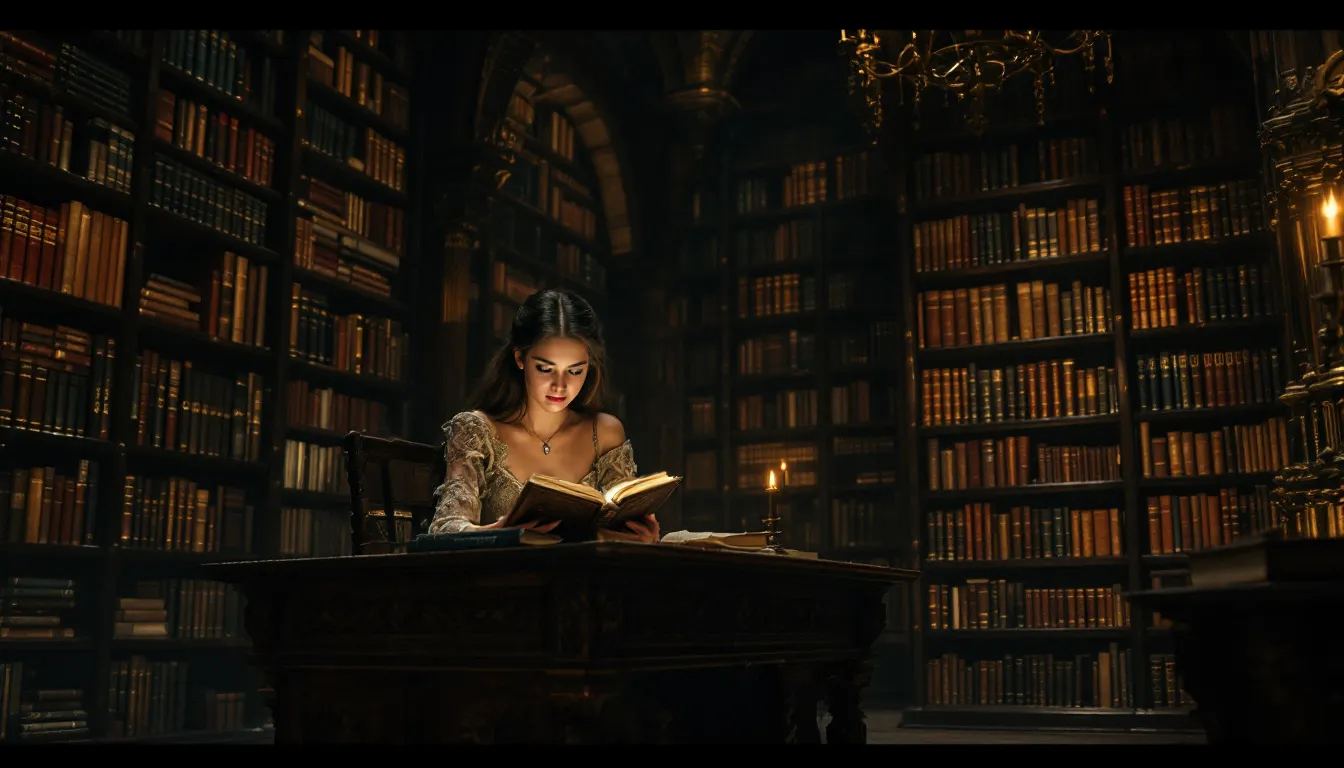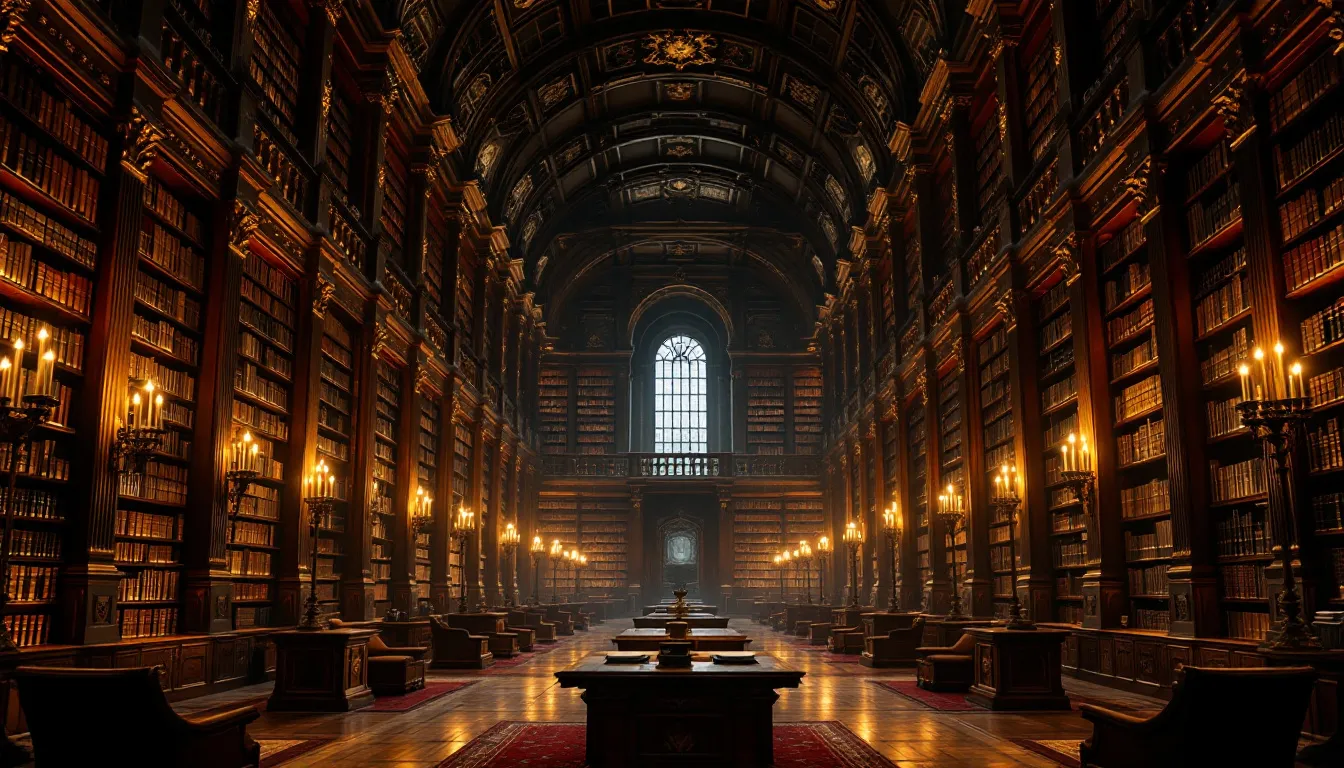
50 Must Read Classics Every Book Lover Should Know
Searching for must read classics? Here are essential novels that have shaped literature and continue to captivate readers. These timeless works provide profound insights into humanity and society, making them perfect for both new readers and literature enthusiasts.
Key Takeaways
-
William Shakespeare’s works explore timeless themes of ambition, love, and internal conflict, making them relevant across generations.
-
Jane Austen provides sharp social commentary in her novels, blending romance with critiques of early 19th-century society, particularly through strong female protagonists.
-
Harper Lee’s ‘To Kill a Mockingbird’ serves as a powerful critique of social injustice, highlighting moral integrity and the importance of empathy through the character of Atticus Finch.
Timeless Works of William Shakespeare

William Shakespeare’s influence on world literature is undeniable. His tragedies, comedies, and histories have captivated audiences for centuries. Shakespeare’s works often delve into themes like ambition, love, and internal conflict, showcasing the complexity of human emotions. His characters frequently embody extreme emotional states, leading to tragic outcomes that resonate with audiences across time.
In ‘Hamlet,’ the themes of revenge, madness, and the blurring of reality play a central role as a Danish prince seeks revenge against his uncle. Similarly, ‘Macbeth’ illustrates the corrupting power of unchecked ambition as the protagonist transforms from a noble warrior to a tyrant. ‘Othello’ explores the destructive nature of jealousy and manipulation, highlighting the downfall of its titular character.
Shakespeare’s ability to explore the dichotomy between appearance and reality prompts audiences to question the truth behind characters’ actions. His timeless works continue to be studied, performed, and revered, proving that the Bard’s insights into the human condition remain as relevant today as ever.
Jane Austen: Social Commentary and Romance

Jane Austen’s novels are celebrated for their sharp wit and keen social critique, engaging readers with insights into early 19th-century provincial life. Her groundbreaking novel, ‘Jane Austen Pride and Prejudice,’ serves as a comedy of manners, satirizing class distinctions and imparting moral lessons about judgment within Regency society. Austen’s work provides a keen insight into human nature, revealing the complexities of relationships and societal expectations.
Austen’s female protagonists, despite their flaws, do not need to change fundamentally to find happiness. This is evident in Elizabeth Bennet of ‘Pride and Prejudice,’ who navigates the challenges of unrequited love and social class to ultimately find happiness with Mr. Darcy. Austen’s portrayal of women is both progressive and relatable, making her novels enduring favorites.
Novels like ‘Emma’ and ‘Sense and Sensibility’ continue to captivate readers with their timeless exploration of love, marriage, and societal norms. Austen’s ability to blend romance with social commentary ensures that her works remain a cornerstone of classic literature.
The Great American Novel: F. Scott Fitzgerald's Legacy

F. Scott Fitzgerald’s ‘The Great Gatsby’ is widely considered one of the greatest novels in American literature and is often hailed as the greatest novel exploring themes of hedonism and disillusionment, depicting an extravagant lifestyle characterized by lavish parties and a quest for pleasure and excess. Fitzgerald’s portrayal of the American Dream is both glamorous and tragic, revealing the moral decay beneath the glittering surface.
Nick Carraway serves as the novel’s narrator, transitioning from an idealistic observer to a critic of the moral decay among the elite. His journey reflects the disillusionment of the post-Great War generation, making ‘The Great Gatsby’ a poignant reflection on the American experience.
At the heart of the novel is Jay Gatsby’s obsessive pursuit of Daisy Buchanan, which highlights the theme of obsessive idealism and leads to his ultimate downfall. Fitzgerald’s masterful storytelling and rich symbolism ensure that ‘The Great Gatsby’ remains a timeless exploration of ambition, love, and the illusions of the American Dream.
Charles Dickens: Stories of Victorian Struggles
Charles Dickens used his novels to shine a light on the grim realities of poverty and social injustice, compelling readers to confront uncomfortable truths about their society. His works often featured serialized narratives that allowed for immediate reader engagement and responsiveness to social issues of the day. Through his vivid characters and intricate plots, Dickens fostered empathy and understanding among his readers.
‘A Tale of Two Cities’ explores themes of sacrifice and transformation against the backdrop of the French Revolution, reflecting societal issues relevant to Dickens’ time. Similarly, ‘Great Expectations’ follows Pip’s journey from poverty to wealth, highlighting the overarching themes of transformation and societal struggle.
Characters like Bob Cratchit and Oliver Twist represent the marginalized, revealing their dreams and struggles to evoke a sense of empathy in readers. Dickens’ ability to portray the struggles of the lower classes with both realism and compassion ensures that his works remain powerful commentaries on the human condition.
Exploring Human Nature with John Steinbeck
John Steinbeck’s novels offer profound insights into human nature and the complexities of the human condition. His works often explore themes of friendship, isolation, and the pursuit of dreams, set against the backdrop of Depression-era America. Steinbeck’s storytelling is both poignant and thought-provoking, making his novels essential readings in world literature.
In ‘Of Mice and Men,’ the friendship between George and Lennie stands in stark contrast to the isolation faced by other characters in the story. The title, inspired by a poem by Robert Burns, reflects on the fragility of human aspirations and plans. The novel highlights the devastating consequences that come from the pursuit of dreams in a harsh and unforgiving world.
Steinbeck’s ability to capture the essence of the human experience through his characters and their struggles ensures that his works remain timeless explorations of the human condition. His novels continue to resonate with readers, offering valuable lessons on resilience, empathy, and the pursuit of a better life.
George Orwell's Dystopian Visions

George Orwell’s dystopian visions offer a chilling critique of totalitarianism and the dark side of human nature. His novels, particularly ‘Nineteen Eighty-Four,’ explore themes of oppression, surveillance, and the manipulation of truth. Orwell’s ability to depict the devastating consequences of unchecked power makes his works essential readings in world literature.
In ‘Nineteen Eighty-Four,’ Big Brother symbolizes the oppressive power of the state, instilling fear in citizens as a method of control. The novel’s use of propaganda through telescreens and slogans manipulates citizens’ loyalty and perception. Language manipulation through Newspeak is a key tactic used by the Party to limit individual thought and reinforce control.
The narrative underscores how loyalty to the Party supersedes personal relationships, as evidenced by Winston and Julia’s doomed love. Orwell’s exploration of these themes serves as a powerful warning about the dangers of totalitarianism and the loss of individual freedoms. His dystopian visions remain relevant today, prompting readers to question the balance between security and liberty.
The Brontë Sisters: Passion and Independence
The Brontë sisters, Charlotte and Emily, are renowned for their passionate and independent female protagonists. Their novels, set against the harsh Yorkshire moors, are imbued with gothic elements and intense emotions. The Brontës’ ability to blend personal struggles with broader societal themes makes their works enduring classics.
Charlotte Brontë’s ‘Jane Eyre’ includes themes of self-discovery and resilience, portraying Jane’s evolution from an orphan to a self-sufficient individual. The main character’s journey details her development from a timid orphan to a strong, principled woman. Challenges faced by Jane include poverty, loss of loved ones, and mysterious noises, showcasing her resilience.
In ‘Wuthering Heights,’ Emily Brontë explores themes of desire and the damaging effects of abuse and isolation on children. The relationship between Cathy and Heathcliff depicts childhood friends separated by class and choices, with an all-consuming passion. The brooding atmosphere of ‘Wuthering Heights’ reflects the tumultuous relationship between its protagonists.
The Brontë sisters’ ability to create unforgettable characters and explore profound themes ensures their place in the pantheon of great novels.
James Joyce: Modernist Innovations
James Joyce is celebrated for his modernist innovations and complex narrative techniques. His works, particularly ‘Ulysses,’ are known for their intricate structure and rich symbolism. Joyce’s ability to capture the intricacies of human consciousness and the mundane aspects of everyday life makes his novels a cornerstone of twentieth-century literature.
In ‘Ulysses,’ the narrative shifts between various styles, enhancing the complexity of the characters’ experiences. Joyce often employs allusions to classical myths, linking everyday events to broader historical contexts. Characters in ‘Ulysses’ experience epiphanies that illuminate themes of identity and self-discovery.
‘Dubliners,’ published in 1914, offers a poignant reflection on the lives of Dublin citizens during that era. The stories convey a common sentiment of Ireland’s stifling paralysis and a restless desire for change. Joyce’s use of symbolism, such as the motif of water representing the passage of time and renewal, adds depth to his exploration of human experiences.
His modernist innovations continue to influence contemporary literature, making his works essential readings for those interested in the evolution of story centres and narrative form.
Thomas Hardy's Tragic Heroines
Thomas Hardy’s novels often highlight the struggles of women against societal constraints and personal tragedies. His portrayal of female characters is both empathetic and progressive, reflecting the limitations imposed on women in the 19th century. Hardy’s ability to create unforgettable characters and explore profound themes makes his works enduring classics.
‘Tess of the d’Urbervilles’ and ‘Far from the Madding Crowd’ offer profound insights into the limitations imposed on women in the 19th century. Bathsheba Everdene is portrayed as a strong, ambitious woman who manages a farm, challenging the norms of her time. Hardy’s female characters experience complex emotions and desires, reflecting a more progressive view of women for the era.
Hardy’s narratives often highlight the struggles of women against societal constraints and personal tragedies. His ability to portray the complexities of women’s lives with both realism and compassion ensures that his works remain powerful commentaries on the human condition.
Harper Lee: Confronting Injustice
Harper Lee’s ‘To Kill a Mockingbird’ stands as a powerful critique of social injustice and racial prejudice. The novel sheds light on the ingrained biases within the Southern legal system and society at large. Through the eyes of Scout Finch, the narrative reveals the harsh realities of discrimination and the importance of empathy and understanding.
Atticus Finch, Scout’s father, serves as a moral beacon in the novel. His unwavering integrity and courage in defending an African American man falsely accused of rape showcase the profound impact one individual can have when standing up against societal prejudice. Atticus’s actions teach his children, and readers, about the value of justice and moral fortitude.
Scout’s reflections on her childhood experiences related to her father’s defense of Tom Robinson highlight the novel’s themes of empathy and understanding. ‘To Kill a Mockingbird’ continues to resonate with readers for its poignant exploration of human rights and its call to confront injustice wherever it exists.
Mark Twain: Adventures and Satire
Mark Twain’s novels, particularly ‘The Adventures of Tom Sawyer’ and ‘Huckleberry Finn,’ are celebrated for their adventurous spirit and satirical edge. Twain’s narrative style draws readers into the world of his characters, offering both entertainment and incisive social commentary.
‘The Adventures of Tom Sawyer’ focuses on the innocent adventures of youth, contrasting with the deeper social issues explored in ‘Huckleberry Finn’. Twain’s use of a first-person perspective in ‘Huckleberry Finn’ allows readers to experience Huck’s internal conflicts and adventures firsthand. The novel addresses themes of freedom, friendship, and the moral dilemmas faced by its young protagonist.
Twain’s ability to blend humor with serious social critique ensures that his works remain relevant and engaging. His exploration of themes such as racism, hypocrisy, and the quest for freedom makes ‘Huckleberry Finn’ a cornerstone of American literature and a must-read for anyone interested in classic novels.
Herman Melville's Epic Tales
Herman Melville’s epic narratives delve into the complexities of human existence and the struggle against incomprehensible forces. His novels, particularly ‘Moby-Dick,’ are renowned for their rich symbolism and exploration of existential themes.
In ‘Moby-Dick,’ the white whale symbolizes both the vastness of nature and the struggle of humanity against an incomprehensible force. Captain Ahab’s relentless pursuit of the whale highlights themes of obsession and revenge, ultimately leading to his downfall. Melville’s masterful storytelling captures the tension between human ambition and the indifferent power of nature.
‘Bartleby, the Scrivener’ explores themes of passive resistance and societal expectations through the character of Bartleby, whose repeated phrase ‘I would prefer not to’ reflects a profound defiance against conformity. Melville’s exploration of isolation and the human condition ensures that his works remain powerful and thought-provoking, especially for the struggling writer.
Virginia Woolf: Stream of Consciousness
Virginia Woolf’s innovative use of the stream of consciousness technique provides deep insights into the minds of her characters. Her novels, such as ‘Mrs. Dalloway’ and ‘To the Lighthouse,’ are celebrated for their exploration of time, consciousness, and women’s independence.
In ‘Mrs. Dalloway,’ Woolf employs the stream of consciousness technique to explore the inner thoughts and experiences of her characters over the course of a single day. This narrative style offers a profound understanding of the characters’ emotions and perceptions. Woolf’s non-linear narrative structure reflects the complexities of time and consciousness, adding depth to her storytelling.
The theme of women’s independence is central in Woolf’s writings, where she critiques societal constraints imposed on female characters. Her exploration of ‘moments of being,’ which emphasize profound experiences of clarity and truth, contrasts with the mundanity of everyday life. Woolf’s innovative narrative techniques and themes continue to influence contemporary literature.
Leo Tolstoy: Russian Epics

Leo Tolstoy’s epic novels, such as ‘War and Peace,’ intricately weave the lives of various characters against the backdrop of historical turmoil. His works explore the duality of war and peace, symbolizing the conflict between external societal struggles and internal human experiences.
‘War and Peace’ showcases the personal growth of its characters amidst the 1812 French invasion, highlighting their development through the trials and tribulations of war. The novel’s intricate plot and rich character development make it one of the greatest novels in world literature.
The Russian word for peace, ‘mir,’ encompasses multiple interpretations, including societal harmony, personal tranquility, and the absence of conflict. Tolstoy’s ability to capture the complexities of human experiences against a historical backdrop ensures that his works remain timeless and relevant.
James Baldwin: Civil Rights and Identity
James Baldwin’s novels, particularly ‘Giovanni’s Room,’ explore themes of identity, sexuality, and civil rights. His works offer a profound insight into the complexities of self-acceptance and societal norms.
‘Giovanni’s Room’ features a white protagonist grappling with his sexuality, illustrating the complexity of identity beyond just race. Baldwin’s exploration of shame highlights the painful journey toward self-acceptance in the face of societal expectations. The straightforward story structure focuses on the protagonist’s internal conflicts, revealing the tragic fate of its characters from the outset.
Baldwin’s ability to tackle complex themes with empathy and insight ensures that his works remain powerful and relevant. His exploration of civil rights and identity continues to resonate with readers, making his novels essential readings for those interested in American literature.
Summary
As we reach the end of our literary journey, it’s clear that the timeless works of these classic authors continue to captivate and inspire readers. From the intricate tales of William Shakespeare to the poignant narratives of John Steinbeck, each author has left an indelible mark on the world of literature.
We’ve explored the themes of love, ambition, injustice, and resilience through the works of Jane Austen, Charles Dickens, F. Scott Fitzgerald, and many others. These great novels offer profound insights into the human condition and remain relevant today, providing valuable lessons and reflections on society and individual experiences.
The enduring relevance of these classic books is a testament to their authors’ genius and their ability to capture the complexities of life. As you continue your literary journey, we encourage you to delve deeper into these works and discover the timeless wisdom they offer.
Frequently Asked Questions
Why are classic novels still relevant today?
Classic novels are still relevant today because they tackle timeless themes and human experiences that we can all relate to. They provide valuable insights into societal issues and personal challenges, making them just as important now as they were when first published.
What makes 'The Great Gatsby' a classic novel?
What makes 'The Great Gatsby' a classic is its deep dive into the American Dream and the disillusionment that often comes with it. Fitzgerald's storytelling and symbolism beautifully capture the complexities of the American experience.
How do Jane Austen's novels critique societal norms?
Austen's novels cleverly expose the limitations of class and marriage norms, making us reflect on the societal pressures of her time. Through her characters' experiences, she challenges these expectations with humor and insight.
What is the significance of George Orwell's 'Nineteen Eighty-Four'?
'Nineteen Eighty-Four' is essential because it starkly illustrates the risks of totalitarianism and the manipulation of truth, making us reflect on the value of individual freedoms. Orwell's warnings about surveillance and propaganda are incredibly relevant today.
Why is 'To Kill a Mockingbird' an important novel?
'To Kill a Mockingbird' is crucial because it tackles social injustice and racial prejudice, teaching us the power of empathy and the importance of standing up against biases. It resonates with readers and encourages us to reflect on our own values and actions.




